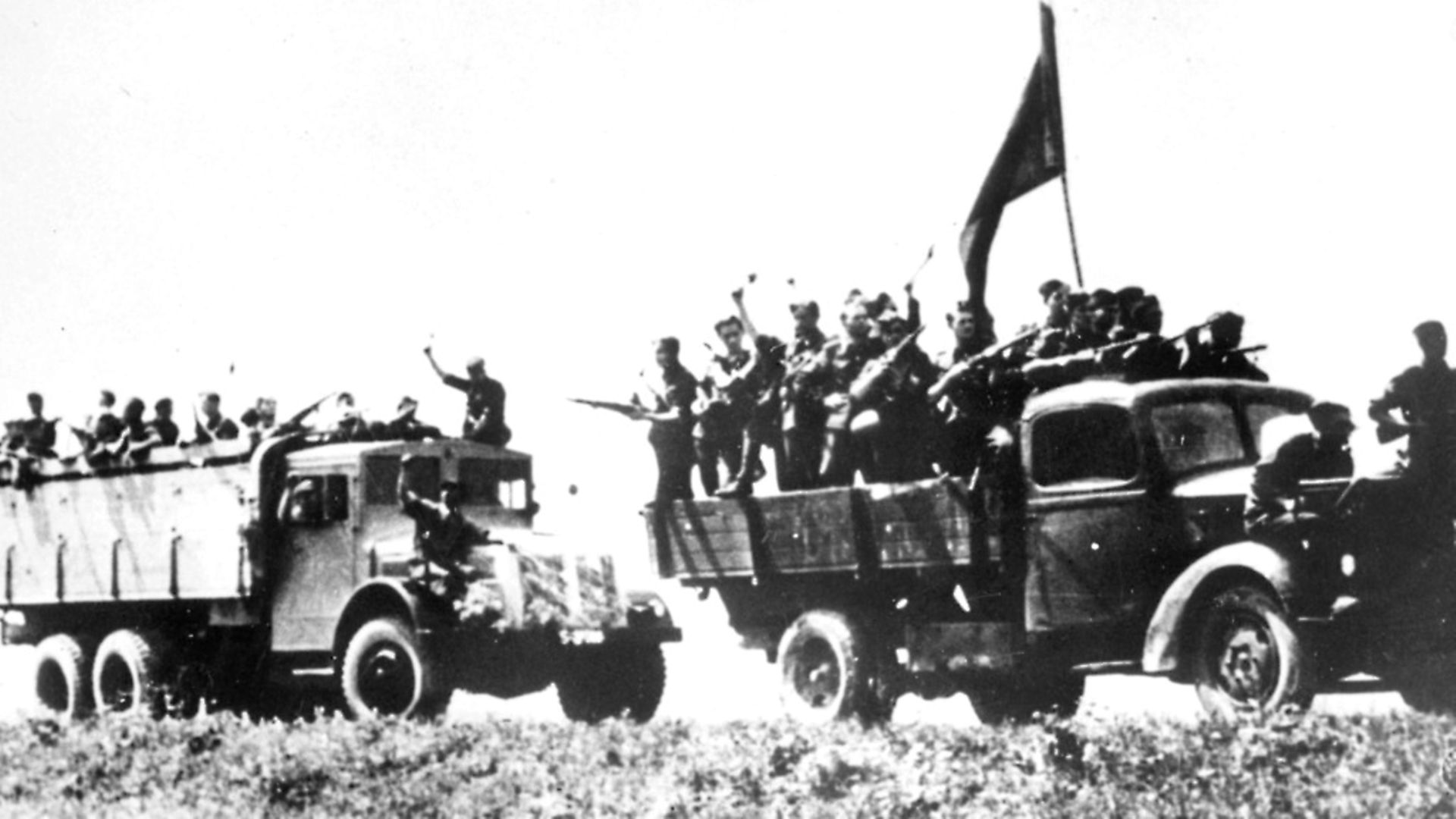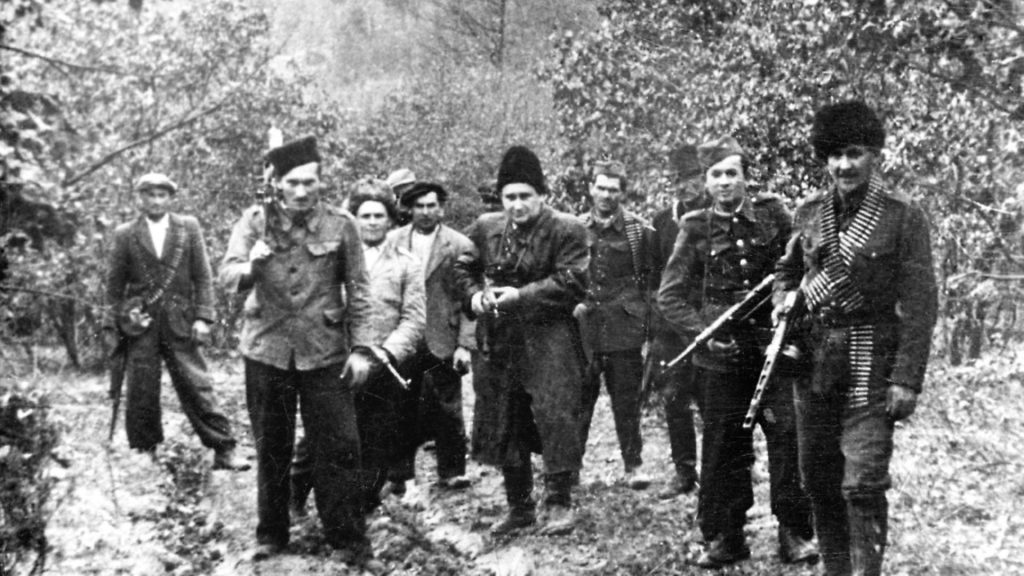
MICK O’HARE tells the story of a revolt that figures as no more than a footnote in the wider history of the Second World War. but arguuably led to the creation of a nation 50 years later.

In 1944, amid the turmoil of, war, a nascent nationalist movement briefly flickered into life. Even though the Slovak National Uprising was brutally crushed by the Nazi regime and remains to outside observers a footnote in the history of the Second World War, arguably it led directly to the separation of Czechoslovakia as a nation 49 years later.
Czechoslovakia was a state bolted together through expediency from the debris of the Austro-Hungarian Empire’s defeat in the First World War. The map of Europe was being redrawn in the aftermath of conflict and while Czechs and Slovaks spoke a similar language, and had a distant shared ethnicity they remained two distinct identities. Relations between the two were always cordial, especially through the era of democracy between the world wars, but the minority Slovaks always laboured under the impression that their bigger and more prosperous neighbour had the better part of the union. The seeds of Slovak nationalism were merely awaiting the right conditions to burst forth.
Czechoslovakia had become an especially prickly thorn in the side of the greater German state during the Second World War. In 1938 the Germans had entered the Czech Sudetenland as part of the Munich agreement brokered by Adolf Hitler and signed by British Prime Minister Neville Chamberlain, French Prime Minister Édouard Daladier and other European leaders. Ostensibly to ‘protect’ the German-speaking population in the Sudentenland and generally welcomed there, the Munich Agreement was widely reviled in the rest of Czechoslovakia and with good reason.
Hindsight has labelled it an act of appeasement by Britain and France, selling out the Czechoslovakians in an attempt to avoid war with Nazi Germany – the Czechoslovak government was not even invited to the talks. But it allowed Chamberlain to return to Britain declaring ‘peace for our time’, the rather deluded outcome of which is now widely known. Yet by March 1939 the rest of the Czech lands had been fully occupied by German troops and Slovakia was ceding from its erstwhile partners to constitute its own pro-Nazi state (in similar fashion to Vichy France) under Catholic priest Jozef Tiso. Unsurprisingly, the essence of an anti-Nazi resistance movement was beginning to distil in both nations.
It culminated in the assassination of Reinhard Heydrich in the spring of 1942. One of the darkest figures in the Nazi regime, and architect of the Holocaust, Heydrich was killed in Prague by British-trained Czech and Slovak resistance fighters under the orders of the London-based Czechoslovak government in exile, headed by former president Edvard Beneš. Repercussions were harsh, but the resistance was undeterred.
By 1944, and with Soviet troops advancing from the east and the western Allies opening up a second front against Germany with the D-Day invasion of Normandy, Slovak partisans were further emboldened. Encouraged by Beneš’s government in exile, they had long been planning to overthrow Tiso’s Nazi state. Germany, realising the emerging threat and coming under increasing pressure from partisan attacks, occupied Slovakia on 28 August. Thus began the Slovak National Uprising, known in Slovak as the Slovenské Národné Povstanie or SNP. Under the command of Lieutenant Colonel Ján Golian the disparate grouping of anti-Nazi Slovak troops, Slovak democrats, communists and others saw this as their opportunity to fight back.
Focused on the town of Banská Bystrica in central Slovakia the uprising was declared on the 29th. Although figures are disputed by historians, possibly 60,000 deserting members of the Slovak army, including some Czechs, plus 12,000 or more partisans of differing factions took up arms against the German occupiers and pro-Nazi Slovaks. The Slovak National Council assumed political power and Free Slovak Radio began broadcasting from the town. But while the rebels fought fiercely, the well-equipped German army always held the upper hand. The rebellion failed to spread into western Slovakia, and when two key Slovak divisions failed to secure the Dukla pass where a connection with the advancing Soviet army was to be forged, the uprising stuttered.
Even at the outset, the odds were against the insurgents. Tiso’s government remained in power in the capital Bratislava and the rebellion became fractious. At Golian’s request he was replaced by General Rudolf Viest who had been in Britain with the government in exile and was flown into Slovakia in October. Viest renamed the rebels the 1st Czechoslovak Army in Slovakia, making clear the government-in-exile’s intent for reunification of the country after the war.
But support from the western Allies remained piecemeal, the Soviet Red Army stalled at the Dukla pass and additionally it has been argued by some that their forces were not encouraged to help the rebels because the uprising was not Soviet-controlled. By the end of October superior German forces had encircled the insurgents.
Many were killed but the remains of the rebellion retreated to the countryside and mountains of the Low Tatras to continue resistance via guerrilla warfare. In retribution there were executions of Slovaks accused of collaborating with the rebels, villages were burnt, inhabitants murdered, and the remaining Slovak Jewish community deported to concentration camps. More than 5000 Slovak citizens were slaughtered.
It cannot be said that the SNP altered the course of the Second World War, and in most histories is mere annotation to the eventual victory of the Allies in Europe. Yet arguably it sowed the seed that led to the separation of the Slovak nation from the Czech lands in 1993 following the peaceful overthrow of the Czechoslovakian one-party communist state in the Velvet Revolution of 1989. But even among Slovaks its legacy is still the subject of debate today. After 1945 its repercussions and significance were shaped and interpreted by numerous ideologies, not least the post-war communist administration who ruled Czechoslovakia as a Soviet satellite state.
They claimed the uprising as a revolutionary act of liberation by communist forces, despite the majority of participants, while anti-Nazi, not being party members. To reinforce this notion the postwar communists attempted to embed their version of the uprising by building the huge, striking concrete SNP museum in Banská Bystrica and constructing the dominating, modernist Most SNP (Bridge of the Uprising) in Bratislava.
But those opposing the communists pointed out that the Soviet Union had not committed troops to help when it could have. Meanwhile, and conversely, Slovak nationalists see the SNP as an act of war against Slovaks themselves in order to maintain Czech domination of the conjoined state of Czechoslovakia, pointing to General Viest’s arrival to take control of what he and the government-in-exiled had called a unified Czechoslovak army. Indeed, others asked if it was even a ‘national’ uprising at all, considering that it involved only a portion of the population. In later years others felt that the rebellion had also been anti-Catholic, fought as it was against Tiso’s ostensibly Catholic Nazi state.
Just as there were many differing motivations for the forces joining the uprising, there were numerous interpretations of its legacy.
This divergence of political opinion has meant that it wasn’t until 2003, ten years after Slovakia split from the Czech Republic, that 29 August became a public holiday. Yet even today many politicians will avoid rhetoric which connects them to the holiday and many Slovaks hold no particular attachment to the date, unlike the way the French celebrate Bastille Day or the Americans the Fourth of July.
Nonetheless, as historian Martin Lacko has noted ‘The fact that an anti-Nazi uprising… was organised in a small, conservative or indifferent Slovakia, can become a source of our pride’. Fellow historian Vilém Pre?an also contends that the uprising created a consciousness in Slovakia, a sense that the nation had ‘its own will, its own idea about its future… to participate in the decision about its destiny’. Slovakia would remain locked in a peaceful embrace with its Czech partners until 1993, but the seeds of separation were perhaps sown in that autumn of 1944.
What can perhaps be safely concluded is that for good or ill the Slovak National Uprising defined Slovakia, certainly as separate from the Czech lands, but also as part of the greater panoply of European Union and world nations.
In 1938 the Germans had entered the Czech Sudetenland as part of the Munich Agreement brokered by Adolf Hitler and signed by British prime minister Neville Chamberlain, his French counterpart Édouard Daladier and other European leaders. Ostensibly to ‘protect’ the German-speaking population in the Sudentenland and generally welcomed there, the Agreement was widely reviled in the rest of Czechoslovakia and with good reason.
Hindsight has seen it as an act of appeasement by Britain and France, selling out the Czechoslovakians in an attempt to avoid war with Nazi Germany. The Czechoslovak government was not even invited to the talks, after which Chamberlain returned to Britain declaring ‘peace for our time’.
But when it led on to full-blown German occupation of the rest of the Czech lands in March 1939, just as Slovakia was ceding from its erstwhile partners to constitute its own pro-Nazi state (in similar fashion to Vichy France) under Catholic priest Jozef Tiso, the essence of an anti-Nazi resistance movement was beginning to distil.
Czechoslovakia was, of course, a nation born from two territories in the aftermath of the First World War – the Czech lands of Bohemia and Moravia, plus Slovakia. Opposition to German control existed in both nations although Slovakia remained an ostensibly Nazi state, unlike the Czech lands under control of the occupying German army.
Regardless, resistance in both grew fierce culminating in the assassination of Reinhard Heydrich in the spring of 1942. One of the darkest figures in the Nazi regime, and architect of the Holocaust, Heydrich was killed in Prague by British-trained Czech and Slovak resistance fighters under the orders of the London-based Czechoslovak government in exile, headed by former president Edvard Beneš.
By 1944, and with Soviet troops advancing from the east and the western Allies opening up a second front against Germany with the D-Day invasion of Normandy, Czech and Slovak resistance was emboldened. Slovak partisans, encouraged by Beneš’s government in exile, had long been planning to overthrow Tiso’s Nazi state and Germany, realising the emerging threat and coming under increasing pressure from partisan attacks, occupied Slovakia on 28 August. Thus began the Slovak National Uprising of 1944, known in Slovak as the Slovenské Národné Povstanie or SNP.
Under the command of Lieutenant Colonel Ján Golian the disparate grouping of anti-Nazi Slovak troops, Slovak democrats, communists and others took this as their opportunity to fight back.
Focused on the town of Banská Bystrica in central Slovakia the uprising was declared on the 29th. Although figures are disputed by historians, possibly 60,000 deserting members of the Slovak army, including Czechs, plus 12,000 or more partisans of differing factions took up arms against the German occupiers and pro-Nazi Slovaks. The Slovak National Council assumed political power and Free Slovak Radio began broadcasting from the town.
But while the rebels fought fiercely, the well-equipped German army always held the upper hand. The rebellion failed to spread into western Slovakia, and when two key Slovak divisions failed to secure the Dukla pass where a connection with the advancing Soviet army was to be forged, the uprising stuttered.
Even at the outset, the odds were against the insurgents. Tiso’s government remained in power in the capital Bratislava and the rebellion became fractious. At Golian’s request he was replaced by General Rudolf Viest who had been in Britain with the government in exile and was flown into Slovakia in October.
Viest renamed the rebels the 1st Czechoslovak Army in Slovakia, making clear the government-in-exile’s intent for reunification of the country after the war. But support from the western Allies remained piecemeal, the Soviet Red Army stalled at the Dukla pass and additionally it has been argued by some that their forces were not encouraged to help the rebels because the uprising was not Soviet-controlled.
By the end of October superior German forces had encircled the insurgents. Many were killed but the remains of the rebellion retreated to the countryside and mountains of the Low Tatras to continue the resistance via guerrilla warfare. In retribution there were executions of Slovaks accused of collaborating with the rebels, villages were burnt, inhabitants murdered, and the remaining Slovak Jewish community deported to concentration camps. More than 5000 Slovak citizens were slaughtered.
It cannot be said that the SNP altered the course of the Second World War, and in most histories is a footnote to the eventual victory of the Allies in Europe.
Yet arguably it sowed the seed that led to the separation of the Slovak state from the Czech lands in 1993 following the peaceful overthrow of the Czechoslovakian one-party communist state in the Velvet Revolution of 1989. But even among Slovaks its legacy is still the subject of debate today.
After 1945 its repercussions and significance were shaped and interpreted by numerous ideologies, not least the post-war communist administration who ruled Czechoslovakia as a Soviet satellite state. They claimed the uprising as a revolutionary act of liberation by communist forces, despite the majority of participants, while anti-Nazi, not being party members. To reinforce this notion the postwar communists attempted to embed their version of the uprising by building the huge, striking concrete SNP museum in Banská Bystrica and constructing the dominating, modernist Most SNP (Bridge of the Uprising) in Bratislava.
But those opposing the communists pointed out that the Soviet Union had not committed troops to help when it could have. Meanwhile, and conversely, Slovak nationalists see the SNP as an act of war against Slovaks themselves in order to maintain Czech domination of the conjoined state of Czechoslovakia, pointing to General Viest’s arrival to take control of what he and the government-in-exiled had called a unified Czechoslovak army. Indeed, others asked if it was even a ‘national’ uprising at all, considering that it involved only a portion of the population. In later years others felt that the rebellion had also been anti-Catholic, fought as it was against Tiso’s ostensibly Catholic Nazi state. Just as there were many differing motivations for the forces joining the uprising, there were numerous interpretations of its legacy.
This divergence of political opinion has meant that it wasn’t until 2003, ten years after Slovakia split from the Czech Republic, that 29 August became a public holiday. Yet even today many politicians will avoid rhetoric which connects them to the holiday and many Slovaks hold no particular attachment to the date, unlike the way the French celebrate Bastille Day or the Americans the Fourth of July.
Nonetheless, as historian Martin Lacko has noted ‘The fact that an anti-Nazi uprising… was organised in a small, conservative or indifferent Slovakia, can become a source of our pride’. Fellow historian Vilém Pre?an also contends that the uprising created a consciousness in Slovakia, a sense that the nation had ‘its own will, its own idea about its future… to participate in the decision about its destiny’. Slovakia would remain locked in a peaceful embrace with its Czech partners until 1993, but the seeds of separation were perhaps sown in that autumn of 1944.
What can perhaps be safely concluded is that for good or ill the Slovak National Uprising defined Slovakia, certainly as separate from the Czech lands, but also as part of the greater panoply of European Union and world nations.










